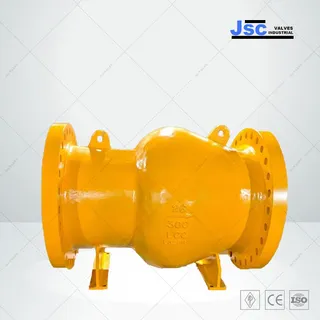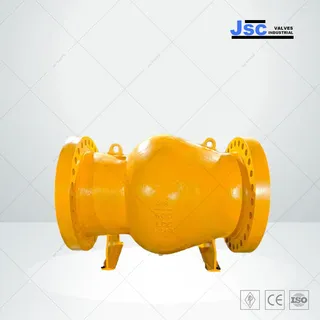Check Valves
A Check Valve, also referred to as a non-return valve or one-way valve, is a mechanical device specifically engineered to permit the flow of fluid (liquid or gas) in a single direction while preventing any reverse or backflow. These valves play a critical role in piping systems by ensuring the unidirectional flow of fluids, thereby averting potential damage or inefficiencies resulting from backflow.
1-12 of 41 results
Our ASTM A352 LCC check valves are manufactured according to API6D,BS 1868 and ASME B16.34 standards. Designed for reliability, they come in a size of 26 inches (DN650) with a pressure rating of Class300 LB (PN50). These valves feature axial flow, non-slam characteristics, low pressure loss, and RF ends for secure connections.
Our ASTM A352 LCC check valves are manufactured according to API6D,BS 1868 and ASME B16.34 standards. Designed for reliability, they come in a size of 28 inches (DN700) with a pressure rating of Class 600 LB (PN100). These valves feature axial flow, non-slam characteristics, low pressure loss, and RF ends for secure connections.
JSC-241230-SCV-01
We specialize in manufacturing bolted bonnet swing check valves meeting ASTM A352 WCB standards and API 6D specifications. These valves, with a size of 16 inches (DN400) and pressure ratings of Class 600 LB and PN100, offer reliable performance in various industrial applications. Featuring a full bore design and STL metal seat, they ensure efficient flow control and tight shut-off. The RTJ ends provide secure sealing, enhancing operational safety. Trust our swing check valves for robust construction, dependable operation, and adherence to stringent quality standards.
JSC-240511-WCV-01
Our ASTM A352 LCB check valves are manufactured according to BS 1868 and ASME B16.34 standards. Designed for reliability, they come in a size of 16 inches (DN400) with a pressure rating of Class 150 LB (PN20). These valves feature axial flow, non-slam characteristics, low pressure loss, and RF ends for secure connections.
JSC-240511-SCV-02
We manufacture JIS swing check valves in China, crafted from forged carbon steel ASTM A105N, ideal for DN15 (1/2 inch) pipelines with 10K (Class 125 LB) pressure rating. These valves feature a 13Cr metal seat for durability and are equipped with RF flanged ends for easy installation and secure sealing.
JSC-240511-SCV-01
Our plant in China specializes in manufacturing carbon steel swing check valves designed to BS 1868 standards. These valves are crafted from ASTM A216 WCB and are available in a size of 24 inches (DN600), suitable for Class 150 LB or PN20 applications. Featuring a bolted bonnet and STL metal seat, they ensure reliable performance and are equipped with flanged ends for easy installation.
JSC-240428-SCV-03
Explore our carbon steel swing check valves meticulously crafted from ASTM A216 WCB steel, designed to meet DIN 3356 standards. With a robust 6-inch (DN150) size and a sturdy Class 300 LB (PN40) pressure rating, these valves offer reliability and durability for various industrial applications. Featuring a bolted bonnet, integral seat, and Stellite face, they ensure secure sealing and enhanced resistance to wear and corrosion. With RF ends, they provide easy integration into your piping systems.
JSC-240428-SCV-02
Explore our forged swing check valve, meticulously crafted from ASTM A105N material in accordance with API 602 standards, ensuring robustness and reliability. With a size of 1-1/2 inches and a pressure rating of Class 300 LB, it offers versatility and resilience for various industrial applications. The valve is equipped with a durable 13Cr metal seat, ensuring secure sealing and long-term performance.
JSC-240428-SCV-01
Discover our ASTM A182 F316 swing check valve, designed to meet API 602 standards for exceptional performance and reliability. Crafted from forged stainless steel, this valve ensures durability and corrosion resistance. With a size of 1 inch (DN25) and a pressure rating of Class 800 LB (PN150), it offers versatility for various applications. Equipped with an SS 316 plus STL metal seat and NPT ends, it ensures secure sealing and easy installation.
JSC-240418-SCV-01
Discover our swing check valve sourced from China, engineered from robust ASTM A217 WC6 material and adhering to BS 1868 standards. With a size of 12 inches (DN300) and a high-pressure rating of Class 1500 LB (PN250), it ensures reliable performance even in demanding conditions. Featuring a pressure seal bonnet (PSB) and renewable seat, along with butt-weld (BW) ends, it offers secure and efficient fluid control for your industrial applications.
JSC-240418-WCV-01
Discover our high-quality non-slam axial check valve, expertly crafted from ASTM B148 C95800 bronze, meeting BS 1868 and ASME B16.34 standards. With a generous 6-inch (DN150) size and Class 150 LB (PN20) rating, this valve ensures reliable performance in various applications. Featuring metal seating, it minimizes pressure loss and guarantees efficient fluid flow. Trust in its superior design to prevent water hammer and ensure smooth operation in your systems.
JSC-240418-FSCV-01
Discover our meticulously crafted ASTM A105N Y type check valve, engineered from forged carbon steel to ensure durability and reliability. With adherence to API 602 and ASME 16.34 standards, this valve guarantees optimal performance. Featuring a 3/4-inch size (DN20), Class 800 LB (PN150) rating, and 13cr metal seat, it's designed to withstand high pressures and harsh conditions. The NPT end connection ensures easy installation and secure sealing for your piping systems.
The major components of a check valve include:
Body: The external shell housing the internal components of the check valve. Engineered to endure pressure and serve as a connection point within the piping system.
Disk (or Flap, Ball, or Piston): The movable element that either permits or obstructs the flow of fluid. Positioned to seal the valve during reverse flow, preventing fluid from moving in the opposite direction.
Seat: The fixed surface against which the disk forms a seal, establishing a barrier to fluid flow in the reverse direction.
Spring (if applicable): In certain check valves, a spring may be included to aid in promptly and effectively closing the valve when reverse flow is detected.
Hinge Pin (if applicable): In swing check valves, the disk is connected to the body via a hinge pin, enabling it to swing open or closed based on the flow direction.
There are several types of check valves, each designed to suit specific applications and operational requirements. The main types of check valves include:
Swing Check Valve: This check valve utilizes a hinged disk that swings open during forward flow, enabling fluid passage. When the flow reverses, the disk swings closed, preventing backflow.
Lift Check Valve: This check valve features a disk that lifts away from the seat during forward flow and descends back into place under the influence of gravity when flow reverses.
Ball Check Valve: This check valve employs a ball as the movable component. The ball lifts off the seat during forward flow and resettles to prevent reverse flow.
Tilting Disc Check Valve: This check valve incorporates a disc that tilts to permit forward flow and returns to a horizontal position to impede backflow.
Diaphragm Check Valve: This check valve operates using a flexible diaphragm that flexes to allow forward flow and reverts to its original position to obstruct reverse flow.
Check valves offer several advantages in various industrial applications due to their design and functionality. Here are some key advantages of check valves:
1. Prevention of Backflow: Check valves serve their primary function by preventing the reverse flow of fluid, ensuring unidirectional flow to protect equipment and maintain system integrity.
2. Automatic Operation: Operating automatically without external control, check valves respond to changes in flow direction, facilitating seamless and continuous operation without the need for manual intervention.
3. Reduced Water Hammer: Check valves play a role in minimizing water hammer, the sudden pressure increase resulting from the abrupt stoppage of fluid flow. The valve's quick closure helps prevent potential damage to pipes and equipment.
4. Energy Efficiency: By preventing backflow, check valves promote energy efficiency in pumping systems. They ensure a continuous and unidirectional flow, reducing the demand for additional pumping power to overcome backflow resistance.
5. Space Efficiency: Compact in design, check valves are well-suited for applications with space constraints. Their small size allows for easy integration into existing piping systems.
Check valves find diverse applications across various industries due to their ability to prevent backflow and maintain the unidirectional flow of fluids. Here are common applications of check valves:
Water and Wastewater Systems: Prevent backflow in water distribution systems, safeguarding water quality, and controlling wastewater flow in sewage systems.
Oil and Gas Industry: Installed in pipelines to prevent reverse fluid flow during oil, natural gas, and fluid processing in extraction, transportation, and refining operations.
Chemical Processing Plants: Used to control chemical flow, ensuring unidirectional movement to prevent cross-contamination and maintain process integrity in chemical processing plants.
HVAC Systems: Regulate refrigerant flow in heating, ventilation, and air conditioning systems, preventing backflow and ensuring the efficient operation of the HVAC system.
Fire Protection Systems: Integrated into fire sprinkler systems and hydrants to prevent water or fire extinguishing agent backflow, ensuring the readiness and reliability of firefighting equipment.












